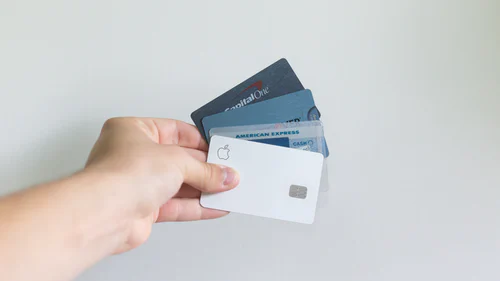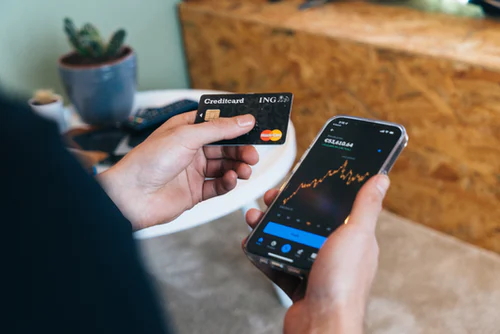Cashback
A credit card perk that enables the user to retain a percentage of their purchases made using the card.
Credit cards offer many perks to attract customers and compete with other companies. Cashback is one credit card perk that enables users to retain a percentage of their purchases made using the card.

Reward programs for spending money have existed for decades.
One of the most popular of the 1900s was the S&H Green Stamps program, where consumers would collect stamps from grocery stores, gas stations, and department stores and trade them in for items from the S&H catalog.
Although rudimentary, programs like these were pioneers for credit card cashback.
While early forms of credit emerged in the 1900s, it wasn’t until 1986 when Discover Financial Services launched a credit card with a rewards bonus on certain purchases.
Earning cashback on purchases allows the consumer to earn a percentage of their eligible spending. For example, let’s say your credit card offers 1.5 percent cashback on all purchases, then you would earn 1.5 cents in rewards for every dollar spent.
These programs incentivize consumers to use the card more because the more they spend, the more cash they can earn back.
Some companies may offer a flat rate on all purchases, and some may provide varying percentages on different types of purchases.
Some examples of popular spending categories are:
- Grocery stores
- Fitness club and gym memberships
- Gas stations
- Restaurants
- PayPal
- Airlines
- Hotels
- Home Improvement
- Entertainment

Some travel credit cards offer miles or points that can be redeemed, but cashback rewards are purely a monetary value.
The four most common forms are:
- Flat-rate
- Bonus category
- Rotating Category
- Choose-your-own Category
We will address these in detail in the section below.
It can vary depending on the company, and this is one of the primary characteristics people research before choosing a credit card. It’s important to research what rewards program fits your spending habits and financial situation.
Understanding the concept
Assume a scenario where a credit card company charges merchants a 3% transaction fee. Now consider that you spent $20,000 over one year and strictly used the credit card that offers 1.5% back on all purchases.
The credit card company would pay you $300 ($20,000 x 1.5%) in cash back and collect $600 ($20,000 x 3%) in transaction fees from all merchants accepting the credit card. This results in net revenue of $300 for the credit card company.
As a result of these programs, people are incentivized to use credit cards for their purchases, which generates more revenue for the credit card company.

Advantages
- Requires minimal effort other than using the card on purchases
- The value of the cash cannot be devalued, unlike travel miles, where the value is to the discretion of the card issuer and can change at any time
- Some cards come with cash signup bonuses
- Some cards come with cashback matching for a specified period (if you earn $75 in cashback, the credit issuer will match that $75)
Disadvantages
- Travel rewards may have the potential to be more valuable than cash rewards.
- There may be a maximum limit of cash you can earn
- Some cards expire rewards due to account closures, missed payments, or inactivity.
- Some of the best rewards cards come with an annual fee
Examples of Credit Cards
Different credit cards have different offers for earning cashback. In addition, certain restrictions, such as credit score, could limit your ability to get a credit card. Below are some of the most common credit cards for earning cash on purchases.
Discover it CashBack
- Discover automatically matches all the cash back earned at the end of your first year using the card
- Earn 5% back on a rotating category that changes quarterly
- Earn 1% unlimited cashback on all other purchases
- No annual fee
- Recommended credit score: 690-850

Chase Freedom Unlimited
- Earn 6.5% back on travel for the first year (up to $20,000), then 5% after
- Earn 4.5% back on drugstore purchases, restaurants, and eligible delivery services for the first year (up to $20,000), then 3% after
- Earn 3% back on all other purchases for the first year (up to $20,000), then 1.5% after
- No annual fee
- Recommended credit score: 690-850
Wells Fargo Active Cash Card
- Earn a $200 bonus when you spend $1,000 in your first three months using the card
- Earn unlimited 2% back on all purchases
- No annual fee
- Recommended credit score: 690-850
As seen in the above examples, each credit card has its terms and conditions, so research your options. Note that there are dozens of cards to choose from, and the three listed above are just examples.
Most Common Forms
The amount of cash you can earn on purchases with a credit card depends on the lending agency. Some may have temporary bonus programs, while others may have a higher constant percentage rate of cashback.
You should always research options to decide which credit card aligns with your most common purchases. For example, if the rate is higher for travel purchases, but you never travel, you might benefit from using a different card.
1. Flat-Rate:
Flat-rate offers a constant percentage of all qualifying purchases. The store where you use the credit card does not affect the percentage earned.
For example, if you earned 1.5% back on all purchases and spent $1,000, you would receive a $15.
2. Bonus Category:
Some credit cards offer a higher percentage on certain purchases, like travel or groceries. Bonus categories are typically in addition to a flat rate on all other purchases.
For example, if you used the credit card to buy $100 worth of groceries and your card offers 5% back at grocery stores, then you would earn $5 back.

3. Rotating Category:
Similar to bonus category rewards, rotating category cards offer higher cashback on certain purchases on a rotating basis. These categories often rotate every quarter and may require activation before earning the increased rewards.
For example, this is the cashback calendar for a Discover credit card, where you earn 5% from these categories.
| Jan-Mar | Apr-Jun | Jul-Sep | Oct-Dec |
|---|---|---|---|
| Grocery Stores and Fitness Club & Gym Memberships | Gas Stations and Target | Restaurants and PayPal | Amazon.com and Digital Wallets |
4. Choose-your-own Category:
Some companies allow customers to select their bonus category for more flexibility. This bonus category earns a higher percentage of cashback compared to all other purchases. You will typically be offered a list of categories to choose from.
You can usually only change your category allocation once per calendar month.
For example, a Bank of America credit card allows you to choose from six categories where you can earn 3% back:
- Gas
- Online shopping
- Dining
- Travel
- Drugstores
- Home improvement and furniture
Ensure that you consider your spending habits when choosing a credit card to capitalize on the rewards program that best fits your needs.
Redeeming Cashback
Some companies may have a minimum spending threshold before it can be redeemed, so it is important to read the terms of the credit card.
How you utilize the cash you earn from using the card is up to you, but there are numerous options with no significant advantages in one way or another.
For example, attributing the cash to your next statement does not have any added benefit compared to using the reward amount toward a purchase on Amazon or PayPal.
Many companies also provide a cash matching program. For instance, let’s say your credit card company will match the amount you earn from cashback in your first year. So, let’s say you spend $5,000 on that card and get 2% back. This means you get $100 back.
With this matching program, you would get an additional $100 back from the credit card company, so $200 in total rewards.

Cash earned on purchases can typically be redeemed in the following ways:
- First, the cash can be deposited directly into your checking or savings account.
- The amount can be attributed to your next credit card payment. For example, if you earned $7 in cashback and your credit card balance is $50, you could apply that $7 and pay the remaining $43 on your statement.
- Some companies may offer the option to redeem the cashback for a gift card to specified retailers.
- You may be able to directly link your rewards to a PayPal or Amazon.com account, where you can use the rewards towards purchases made through these third parties.
- Many credit cards offer the opportunity to donate cash to a charity of your choice.
FAQs
Even though credit card companies have to pay cashback, they can capitalize on the transaction fees generated by merchants. Typically, credit card companies receive more transaction fees than the amount of cash they give back to their clients.
For instance, when a consumer makes a purchase using a credit card, the credit card company collects 2% of the revenue generated by the merchant. Then the credit card company gives the consumer 1.5% of their purchases back and profits 0.5% of the purchase from the transaction.
Furthermore, these incentives can cause consumers to overspend and become forced into paying interest payments because they cannot afford to pay the statement in full.
Finally, some credit cards are accompanied by an annual consumer fee.
Unless there is an annual fee, the money you earn back from your credit card is free. Therefore, it is not considered taxable income. However, you must spend money to earn money, so in that respect, it is not free.
There is no limit to how many credit cards you can have to maximize your rewards, but opening a new account can have an impact on your credit score.
Additionally, some cards may have a minimum spending requirement before you can take advantage of the rewards program.
The perks of a credit card, especially the cashback, can be a nice feature if used responsibly. Always pay off the statement and never carry a debt balance. Interest on late payments can quickly wipe out any cashback earned.
If you’re confident you can always pay off the balance, the extra cash is a nice financial kickback for spending.
Credit cards typically offer between 0.5% and 1.5% on all purchases. Some credit issuers offer bonus categories where you can earn up to 5% on certain purchases.









or Want to Sign up with your social account?